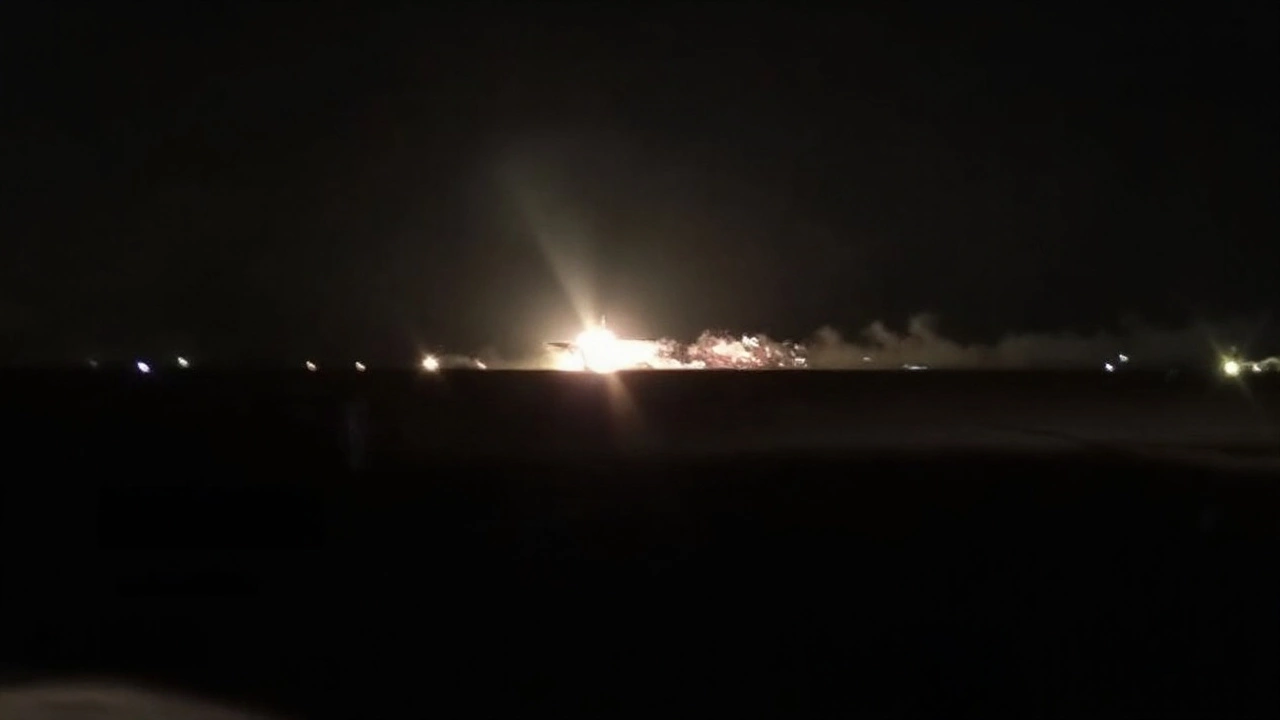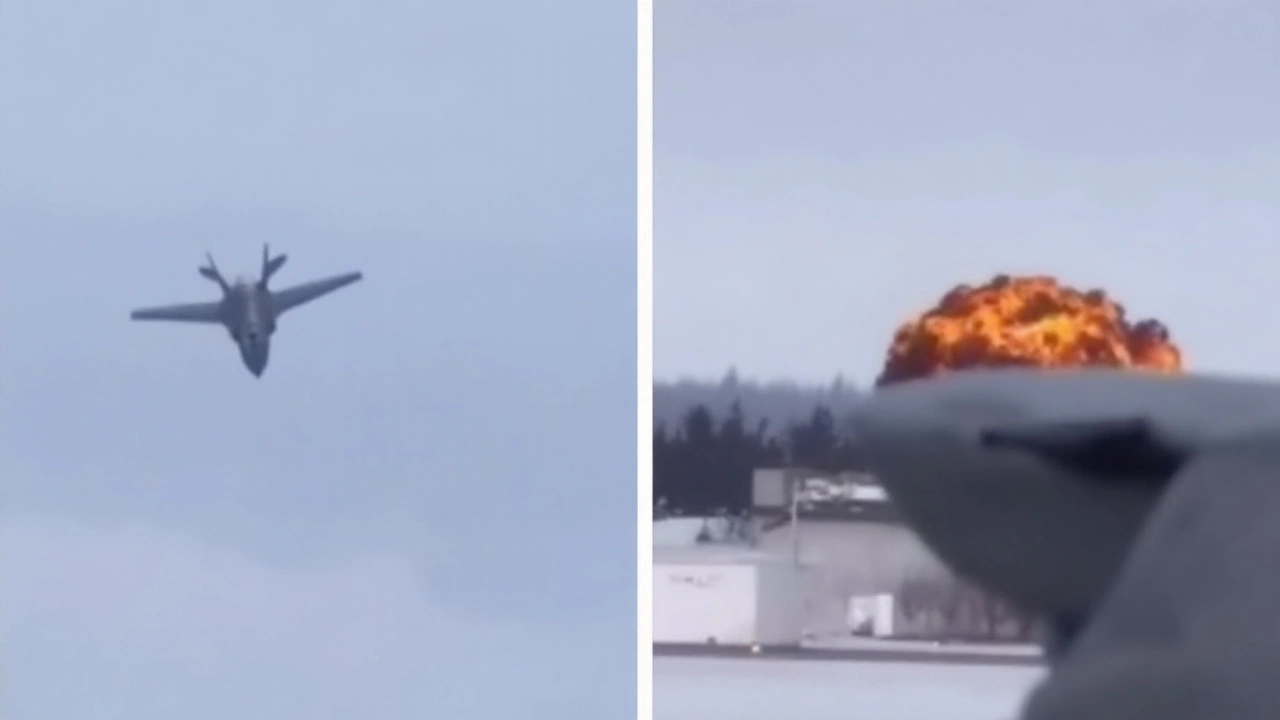What happened at Radom
One of Poland’s frontline F-16s went down in a violent runway impact during a rehearsal at Warsaw–Radom Airport on August 28, 2025, killing the pilot and wiping out the weekend’s AirSHOW Radom. The moment was caught on multiple cameras. In the clips, the single-seat F-16C appears to enter a rolling maneuver and then descends shallowly toward the concrete. The Pratt & Whitney F100 engine looks to be producing strong thrust right up to impact, judging by the exhaust plume.
The jet struck the runway hard, broke apart, and erupted into a long trail of fire. Airport firefighters reached the wreckage within moments, joined by Ministry of the Interior units staged for the rehearsal. No ejection was seen on video and no injuries to spectators or airport personnel were reported. The runway suffered visible damage from the impact and the heat of the blaze, and other aircraft parked near the fence line were moved away as a precaution.
Defense Minister Władysław Kosiniak‑Kamysz confirmed the death, calling it “a great loss for the air force and the entire Polish military.” Prime Minister Donald Tusk also acknowledged the loss of both aircraft and pilot. Government spokesperson Adam Szłapka said authorities would release details only after initial findings are in. The Deputy Prime Minister and senior air force leadership, including Major General Adam Rzeczkowski, visited the scene shortly after the fire was contained.
The F-16 belonged to the 31st Tactical Air Base near Poznań‑Krzesiny, one of two Polish bases that operate the type. The aircraft was rehearsing for AirSHOW Radom 2025—Poland’s largest aviation event—which was due to feature military teams from across Europe, including the RAF Red Arrows and Finland’s Midnight Hawks. Organizers canceled the entire show after the crash.
Public clips show several other jets waiting at or near the runway during the sequence, including a visible line of F‑16s inside the airport perimeter. Whether airfield layout or traffic added complexity to the routine is unknown; investigators will reconstruct the sequence using video, radar, radio traffic, and onboard data.
For now, authorities have not said whether the broader F‑16 fleet will pause flying. Standard procedure after a fatal crash is to check similar aircraft for any immediate safety issues while the inquiry moves ahead. That can include borescope inspections of engines, control system checks, and a review of recent maintenance logs.
This accident came just days after a separate incident in Malaysia involving a U.S.-made F/A‑18D Hornet that exploded during takeoff, according to local authorities there. There is no evidence the two events are connected, but the timing has sharpened questions about recent fighter safety and display flying risk.

Why it matters and what comes next
The F-16 crash is a blow to Poland’s air force and its largest public aviation showcase. AirSHOW Radom typically draws tens of thousands of visitors, fills hotels across the region, and serves as a centerpiece for military outreach. Canceling the weekend program was the only responsible move: the runway needs repair, and the service needs space to investigate and grieve.
Poland operates 48 F‑16C/Ds, procured in the 2000s as Block 52+ jets with upgraded avionics, conformal fuel tanks on some airframes, modern radar, and precision‑strike capability. They anchor Poland’s fast-jet fleet alongside newly acquired FA‑50s and future F‑35As. The F‑16s handle quick reaction alert duties, train with NATO partners, and regularly participate in air policing missions on the alliance’s eastern flank.
Display flying is inherently higher risk than routine training. Pilots fly low, fast, and often near the edges of their normal envelopes to give the public a close look at what these aircraft can do. Safety rules try to tame that risk—minimum altitudes, strict show lines, sterile zones, and pre-approved routines are all standard. Even so, a tiny miscue, a momentary loss of energy, or an unexpected mechanical issue at low altitude leaves almost no margin.
What will investigators look for? First, they will reconstruct the timeline: airspeed, altitude, bank angle, and engine parameters in the final seconds. Modern F‑16s don’t carry airliner-style black boxes, but they do record system data that can survive a crash depending on the damage. Paired with tower recordings, GPS traces (if available), and high-resolution video, analysts can build a precise picture of the jet’s attitude and performance.
They will examine the F100 engine for signs of compressor or turbine damage, foreign object ingestion, or fuel control issues. Control surfaces—elevators, ailerons, and rudder—as well as the fly‑by‑wire computers and their wiring, will get close scrutiny. Maintenance logs will be reviewed for recent work, deferred discrepancies, and any recurring write-ups. Human factors are always part of the mix: pilot workload, G‑forces, visual cues near dusk (the crash occurred around 19:30 local time), and the choreography of the routine.
Investigators will also study environmental conditions. Wind direction and strength, density altitude, runway slope, and even runway visual cues can influence a low‑level roll or pull‑out. If smoke, sun angle, or heat haze reduced contrast against the runway, that could matter. Every factor gets weighed, then either eliminated or flagged as a contributor.
Authorities will avoid speculation until they’ve run through this process, which often takes weeks for a preliminary note and months for a final report. If a specific mechanical fault is identified, the air force can issue an immediate inspection order for the rest of the fleet. If procedure or routine design is a factor, display manuals get updated. If training gaps are found, syllabi change.
The loss resonates beyond Poland. The F‑16 is the workhorse of many NATO air arms and allied forces worldwide. Its safety record over decades is strong, but any fatal mishap—especially in public view—ripples through maintenance, training, and airshow planning calendars. Teams often re‑evaluate altitude floors and lateral separation after crashes like this, even when the root cause turns out to be unique.
The comparison with the Malaysian F/A‑18D incident is unavoidable because both are American-built fighters and both accidents surfaced in the same week. That doesn’t mean there’s a design link. The Hornet and the F‑16 are different airframes with different engines, maintenance ecosystems, and mission histories. What the timing does do is put a spotlight on display risk and on how air forces manage aircraft that are stretching into their third and fourth decades of service while still flying demanding profiles.
Radom’s cancellation is a gut punch for aviation fans and local businesses. Vendors had stocked for a surge, hotels were full, and international teams were already on the ground. Many of those jets will now head home early. Organizers will face practical questions about refunds, rebooking, and insurance. None of that changes the basic truth driving the decision: the military lost a pilot, and the base needed to shift immediately from show mode to investigation and recovery.
For Poland’s air force, the next steps are clinical and familiar. Secure the site. Recover wreckage and any intact memory modules. Document the runway damage and repair it in phases. Debrief controllers, firefighters, and ground crews who worked the emergency. Notify the pilot’s family and unit, and provide support. Then, slowly, return units to normal operations once the safety gates are cleared.
Public communication will matter. Clear updates—what’s known, what isn’t, and what the service is doing about it—help preserve trust at a time when the military is front and center in Polish life and NATO security. Poland’s jets have been busier in recent years, training harder with allies and watching a volatile neighborhood. That reality makes rigorous maintenance and disciplined airshow governance more, not less, important.
There’s also a broader lesson airshow organizers worldwide revisit after tragedies: simplify routines, enforce rest and briefing standards, and design crowd layouts with generous buffers. Many countries now mandate specific altitude minimums for rolling and looping maneuvers based on aircraft type and performance. That won’t eliminate risk. It can keep a survivable mistake from turning fatal.
As for Radom, the pictures of a blazing runway never tell the whole story. Behind them are flight safety engineers combing through charred components, meteorologists reconstructing the air mass over the field, and pilots replaying cockpit flows in their heads to see where margin might have been lost. When the preliminary report lands, it will be dense and clinical. The human part—why the air force flies public displays at all—remains constant: to train, to recruit, to reassure, and to show taxpayers what their money buys. That mission will continue, shaped by whatever the investigators find on the broken concrete in Radom.

Arlen Fitzpatrick
My name is Arlen Fitzpatrick, and I am a sports enthusiast with a passion for soccer. I have spent years studying the intricacies of the game, both as a player and a coach. My expertise in sports has allowed me to analyze matches and predict outcomes with great accuracy. As a writer, I enjoy sharing my knowledge and love for soccer with others, providing insights and engaging stories about the beautiful game. My ultimate goal is to inspire and educate soccer fans, helping them to deepen their understanding and appreciation for the sport.
view all postsWrite a comment